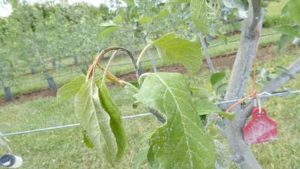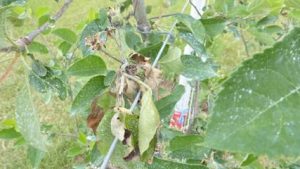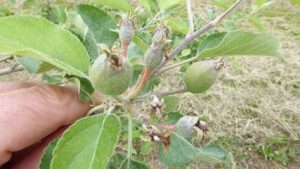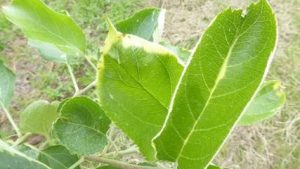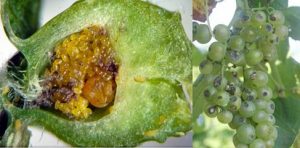By now, you should have thinned shoots down to 4-6 per foot of cordon length, and spaced them evenly through the canopy. Growing shoots are beginning to lignify at the base, which makes combing possible (and timely). Combing the canopy on high-wire training systems by manually separating shoots and pulling them down will greatly facilitate canopy management, fruit sun exposure, spray penetration, and drying of the canopy to reduce disease. This is a very important step that should not be ignored. We have a video of canopy combing from a previous season viewable at: https://www.youtube.com/watch?v=Q-FpRFGy7hM.
Grape diseases remain a concern now as we enter the late-bloom period. All or the major diseases are a threat now, and maintaining fungicide coverage through the next few weeks is of critical importance. A broad-spectrum contact fungicide like captan or mancozeb is recommended and should be combined with a strobilurin (Sovran, Abound), sterol-inhibitor (Rally, Inspire Super), or SDHI (Luna Experience, Aprovia) for extended disease control. This may be the last time to use the mancozeb fungicides, which have a 66-day preharvest interval. Organic growers should keep the fungicide schedule tight, with no more than 7-10 days between applications and careful scouting and removal of diseased leaves and tissues throughout the season. Bordeaux mixture or fixed copper (C-O-C-S, Kocide, Champ) fungicides are the best materials at this time. Risk of black rot infection decreases at 3-4 weeks after bloom, but powdery and downy mildews remain as threats throughout the summer.
I saw a potentially troubling development recently when a grower sent pictures of a Marquette vine that showed decline in vigor and was easily pulled from the ground during cultivation. The roots had deformations known as “nodosities” that are indicative of phylloxera damage. I have not viewed the vine directly and cannot say that insects were present on the roots, but the pictures look pretty conclusive. Most growers are probably familiar with foliar phylloxera which appear as ‘warts’ on leaves which contain a single larvae each. We have often treated these as a generally tolerable annoyance, although some growers have sprayed for them in vineyards with excessive damage. The conventional wisdom has been that American grapes are not economically affected by root-feeding phylloxera in contrast to Vinifera grapes which can be decimated by them and thus are typically grafted onto resistant rootstock of American origin in areas where the pest id present. This observed damage on Marquette suggests that we may be more susceptible, at least on that variety, than previously thought. Much work needs to be done to confirm the pest on Marquette, and to assess best options for management. In the meantime, growers with vineyards that have had high levels of foliar phylloxera, especially on Marquette, may wish to apply a spray to manage the nymphs (“crawlers”) that will move to new tissue and form foliar galls. Systemic insecticides are recommended, and Movento was suggested by Michigan State Extension Entomologist Rufus Isaacs as the most effective material at this time, with a second application suggested 30 days after the first. Organic growers may use Surround crop protectant which is a clay that, when applied to foliage, deters (but does not kill) insects and must be reapplied throughout the growing season as new tissue expands and rain washes the material off. Another benefit of Surround is that it is fairly effective as a deterrent against Japanese beetle. A good fact sheet on phylloxera management can be found at: https://www.uaex.edu/publications/pdf/FSA-7074.pdf. As I mentioned, much remains to be learned about this situation, and I don’t recommend alarm over it. Grape growers have managed phylloxera for the past two hundred or so years since North American varieties have been cultivated and Vinifera distributed around the globe. We’ll keep abreast of this development in the coming weeks.


